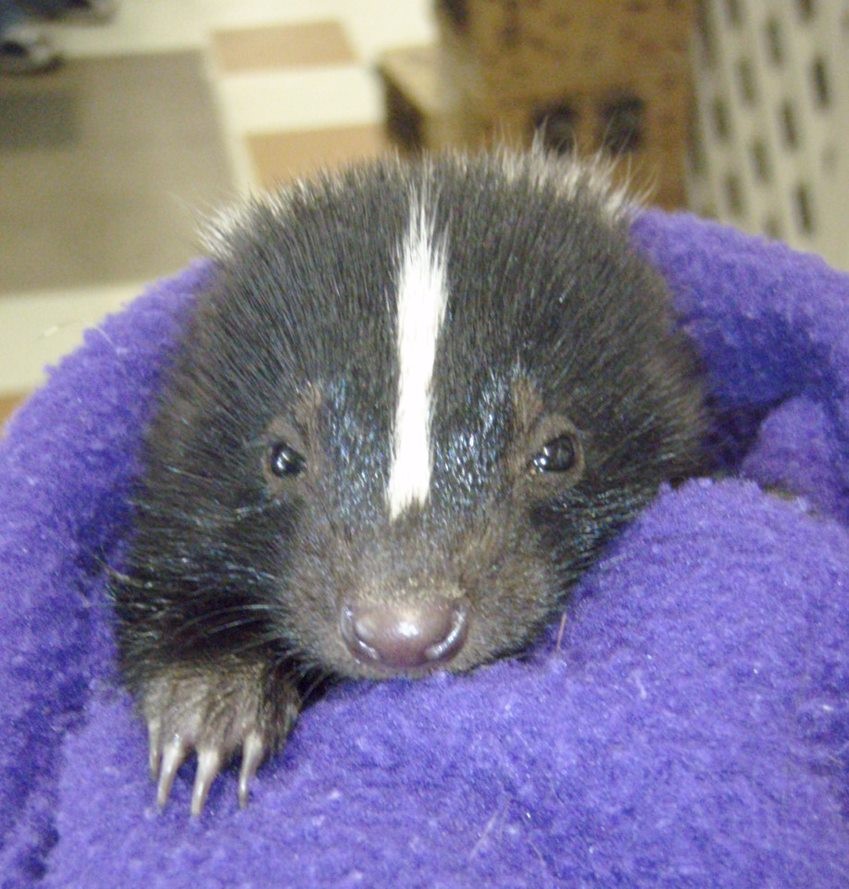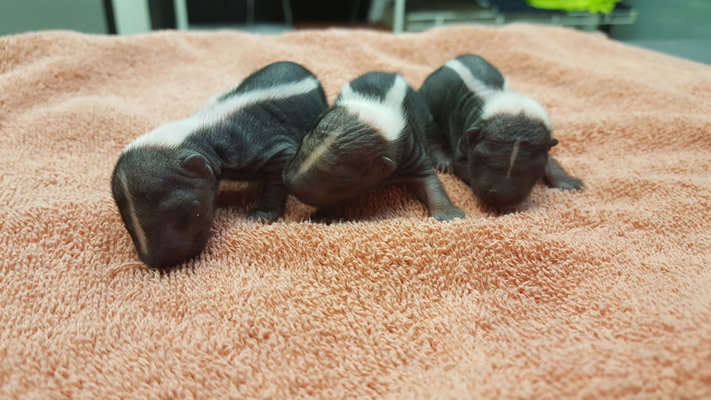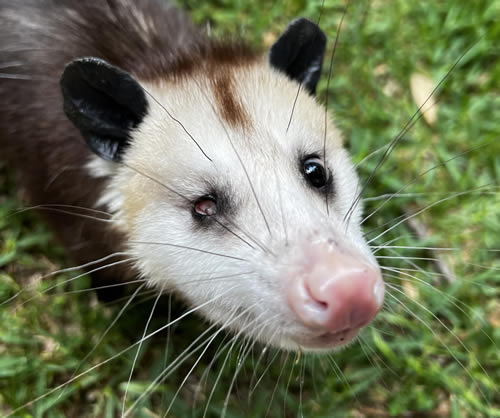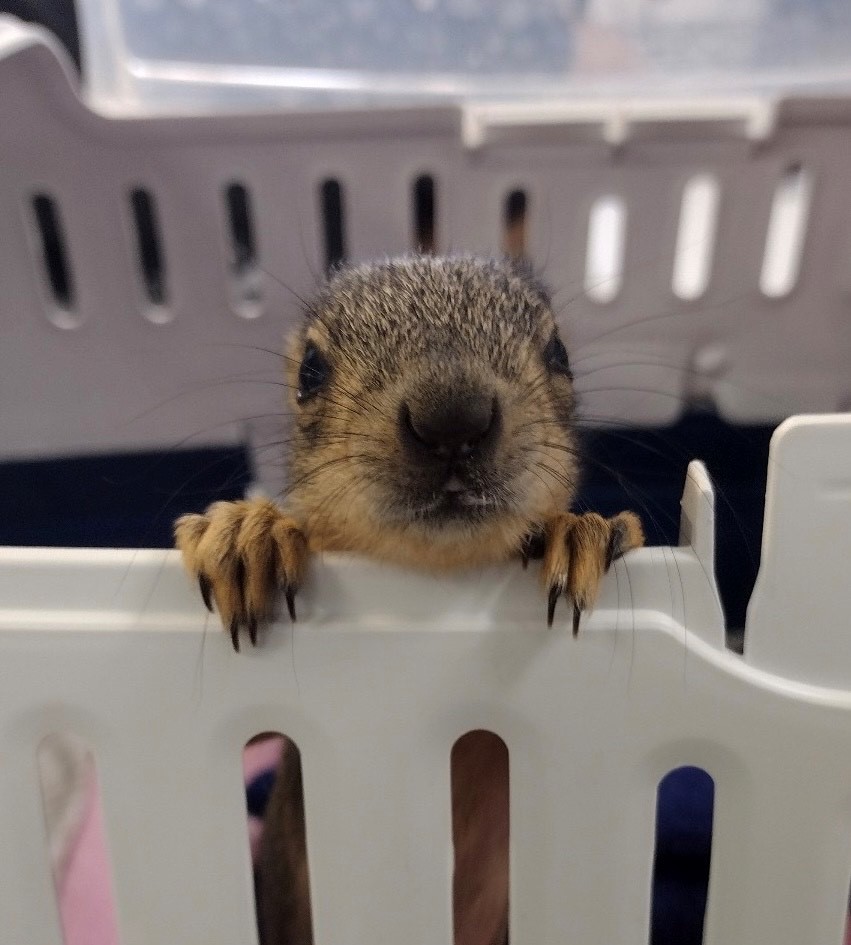RABIES VECTOR SPECIES - POTENTIAL EXPOSURE
Please call 713-767-3300 for Zoonosis Control if there was a potential rabies exposure
WE ARE CURRENTLY NOT ACCEPTING ADMISSIONS FOR THIS SPECIES. PLEASE VISIT ANIMAL HELP NOW TO FIND A WILDLIFE CENTER THAT IS ACCEPTING THEM NEAR YOU.
Have you found a BABY skunk?
If able, please attempt to reunite the baby with its mother. Please do not attempt this if the baby is:
- Caught by a cat or dog
- Visibly injured
- Limping or dragging a limb
- Lethargic (stays in one area for long periods of time)
- Covered in ants, flies, or fly eggs
- Found in an unsafe area (ex: parking lot with no green space around)
- Approaching people


If any of the above apply, we would suggest taking it to a wildlife center for care. Give us a call at 713-468-8972 for further assistance or use Animal Help Now to find a center near you.
If none of the above situations apply, we would suggest trying to reunite the baby with its parents.
Reunite Instructions:
- Prepare a cardboard box by lining it with T-Shirt material. If the babies are mobile, use a container that they cannot get out of, but the mother can get into. We always suggest using a blanket or gloves when handling skunks.
Note If Babies Can Escape From Box: An upside-down laundry basket with a weight on top (such as a heavy book) works well as the babies will not be able to lift the basket, but the mother will be able to push the basket over, freeing her babies. Another possibility is a tall plastic trash can or recycling bin.
- Warm the baby if it is cold. Place the skunk in a box and put the box half-on half-off a heating pad set on low.
Note: Other warming methods include, heating a towel in a dryer and wrapping the baby with it, using a rice sock or plastic bottle filled with hot water wrapped in cloth.
- If the skunk(s) does not warm up after this, it could be lethargic. Call us at 713-468-8972 to bring the skunk to a wildlife center or rehabber.
- Once the baby is warm place them in the cardboard box. Cover the container with a lightweight sheet.
- Place the container in the shade and leave them out from the time they are found until the following morning. The mother will try to retrieve them overnight.
- If the mother does not retrieve her babies, make arrangements to bring them to a wildlife center or rehabber. Use Animal Help Now to find one near you.
Have you found an OLDER baby skunk?
Babies whose body is more than 8 inches long (not including tail) who appear active and healthy and are avoiding people, should be monitored from a distance. If the baby is seen outside the den frequently (all day, or for long periods on consecutive days, or for long periods at night) with no mother present, or if it appears progressively weaker or human-friendly, it should be brought to a wildlife center or rehabber. Use Animal Help Now to find one near you.
Have you found an INJURED or ILL adult skunk?
PLEASE DO NOT TOUCH THE ANIMAL. Adult skunks are very dangerous and are a rabies vector species. Call your county’s Animal Control agency for help with an injured or ill adult skunk.
Temporary Care Instructions for ALL Animals:
- Houston Humane Society Wildlife Center (HHS Wildlife Center) recommends that you wear gloves or use a cloth barrier when handling wildlife.
- Prepare an appropriate-sized cardboard box by poking air holes in the top and placing a soft cloth (T-Shirt, towel, paper towels) in the bottom. DO NOT put the animal into a plastic bag.
- Place the animal into the prepared box and tape the box shut. For injured adults, place the box on its side next to the animal and use a stick, broom, or rolled-up newspaper to gently push the animal into the box.
- Do not give the animal any food or liquids. Feeding an animal an incorrect diet can result in injury or death. In addition, rescued animals can get wet from liquids and become hypothermic and/or spill food on their fur/feathers, potentially causing damage.
- Keep the animal in a warm, dark, quiet place. Darkness makes the animal feel more secure. If the animal is a baby, the box can be placed half on and half off a heating pad set on low. If the animal gets too warm it will move to the other end of the box. Do not place adult animals on a heating pad.
- Leave the animal alone. Human noise, touch, and eye contact are very stressful to wild animals and can result in shock or even death. This is especially important in the case of injured or adult animals.
- If an animal has been caught by a cat or dog, please call HHS Wildlife Center immediately at 713-468-8972. Even if wounds are not visible, the animal needs medical intervention as soon as possible.
- Keep children and pets away. BE CAREFUL! An animal that is hurt or frightened may bite.
- Call HHS Wildlife Center at 713-468-8972 as soon as possible!
General Information about Skunks in the Houston Area
Eating spiders, wasps, and other “pest creatures” makes skunks surprisingly good neighbors to have around. If you see a skunk in your neighborhood enjoy their striking colors from a distance instead of trying to antagonize it. They will often make dens and have kits with them from May to July and rarely in August or September. After this season is over, they will vacate the den, making the fall a good time to close up any holes under sheds or garages that you might not want anyone living under.
The most identifiable characteristic of a skunk is its greatest self-defense weapon. Skunks have 2 musk glands found at the base of their tails. Each skunk can spray an opponent 5-6 times and recharge its musk after only a few days. The kits are not able to spray the musk until they are roughly 4 months old and about 8 inches long. A skunk, however, will only spray you or your pet if it views you as a threat, so keep a distance and move cautiously around them. When feeling threatened, they will stomp their feet before turning around and preparing to spray. If you or your pet is sprayed by a skunk, a solution to get the smell out is to mix 1 quart of 3% hydrogen peroxide, ¼ cup of baking soda, and 1 teaspoon of liquid soap (this can be laundry or dishwashing soap). The hydrogen peroxide may cause some lightning of the fur to your pet so be careful during application.


